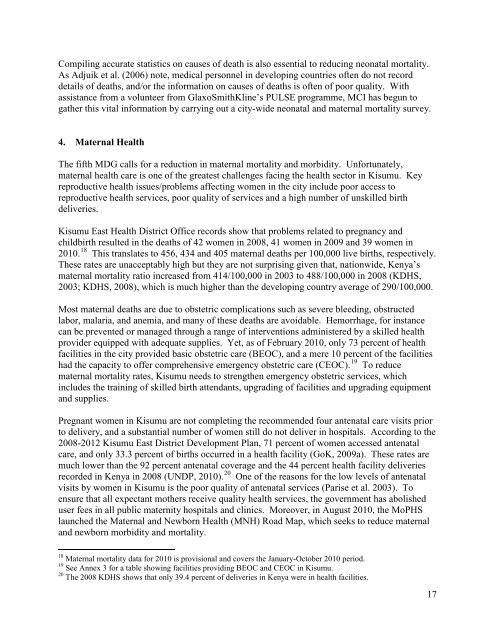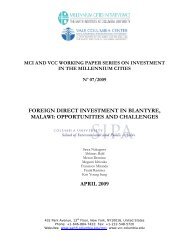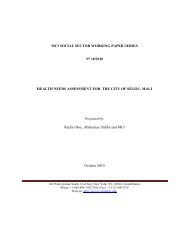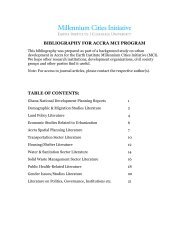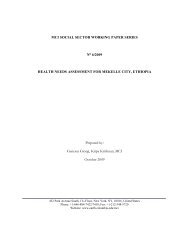Health Needs Assessment for Kisumu, Kenya - Millennium Cities ...
Health Needs Assessment for Kisumu, Kenya - Millennium Cities ...
Health Needs Assessment for Kisumu, Kenya - Millennium Cities ...
You also want an ePaper? Increase the reach of your titles
YUMPU automatically turns print PDFs into web optimized ePapers that Google loves.
Compiling accurate statistics on causes of death is also essential to reducing neonatal mortality.<br />
As Adjuik et al. (2006) note, medical personnel in developing countries often do not record<br />
details of deaths, and/or the in<strong>for</strong>mation on causes of deaths is often of poor quality. With<br />
assistance from a volunteer from GlaxoSmithKline’s PULSE programme, MCI has begun to<br />
gather this vital in<strong>for</strong>mation by carrying out a city-wide neonatal and maternal mortality survey.<br />
4. Maternal <strong>Health</strong><br />
The fifth MDG calls <strong>for</strong> a reduction in maternal mortality and morbidity. Un<strong>for</strong>tunately,<br />
maternal health care is one of the greatest challenges facing the health sector in <strong>Kisumu</strong>. Key<br />
reproductive health issues/problems affecting women in the city include poor access to<br />
reproductive health services, poor quality of services and a high number of unskilled birth<br />
deliveries.<br />
<strong>Kisumu</strong> East <strong>Health</strong> District Office records show that problems related to pregnancy and<br />
childbirth resulted in the deaths of 42 women in 2008, 41 women in 2009 and 39 women in<br />
2010. 18<br />
This translates to 456, 434 and 405 maternal deaths per 100,000 live births, respectively.<br />
These rates are unacceptably high but they are not surprising given that, nationwide, <strong>Kenya</strong>’s<br />
maternal mortality ratio increased from 414/100,000 in 2003 to 488/100,000 in 2008 (KDHS,<br />
2003; KDHS, 2008), which is much higher than the developing country average of 290/100,000.<br />
Most maternal deaths are due to obstetric complications such as severe bleeding, obstructed<br />
labor, malaria, and anemia, and many of these deaths are avoidable. Hemorrhage, <strong>for</strong> instance<br />
can be prevented or managed through a range of interventions administered by a skilled health<br />
provider equipped with adequate supplies. Yet, as of February 2010, only 73 percent of health<br />
facilities in the city provided basic obstetric care (BEOC), and a mere 10 percent of the facilities<br />
had the capacity to offer comprehensive emergency obstetric care (CEOC). 19<br />
To reduce<br />
maternal mortality rates, <strong>Kisumu</strong> needs to strengthen emergency obstetric services, which<br />
includes the training of skilled birth attendants, upgrading of facilities and upgrading equipment<br />
and supplies.<br />
Pregnant women in <strong>Kisumu</strong> are not completing the recommended four antenatal care visits prior<br />
to delivery, and a substantial number of women still do not deliver in hospitals. According to the<br />
2008-2012 <strong>Kisumu</strong> East District Development Plan, 71 percent of women accessed antenatal<br />
care, and only 33.3 percent of births occurred in a health facility (GoK, 2009a). These rates are<br />
much lower than the 92 percent antenatal coverage and the 44 percent health facility deliveries<br />
recorded in <strong>Kenya</strong> in 2008 (UNDP, 2010). 20<br />
One of the reasons <strong>for</strong> the low levels of antenatal<br />
visits by women in <strong>Kisumu</strong> is the poor quality of antenatal services (Parise et al. 2003). To<br />
ensure that all expectant mothers receive quality health services, the government has abolished<br />
user fees in all public maternity hospitals and clinics. Moreover, in August 2010, the MoPHS<br />
launched the Maternal and Newborn <strong>Health</strong> (MNH) Road Map, which seeks to reduce maternal<br />
and newborn morbidity and mortality.<br />
18<br />
Maternal mortality data <strong>for</strong> 2010 is provisional and covers the January-October 2010 period.<br />
19<br />
See Annex 3 <strong>for</strong> a table showing facilities providing BEOC and CEOC in <strong>Kisumu</strong>.<br />
20<br />
The 2008 KDHS shows that only 39.4 percent of deliveries in <strong>Kenya</strong> were in health facilities.<br />
17


